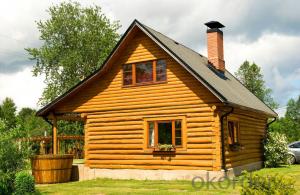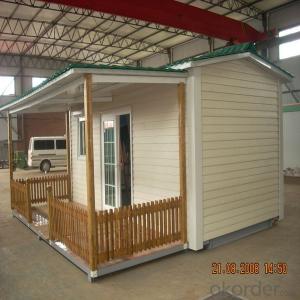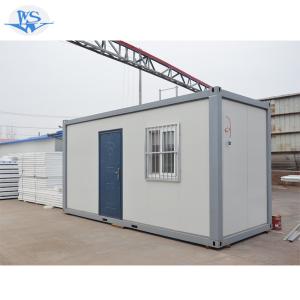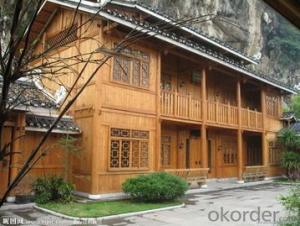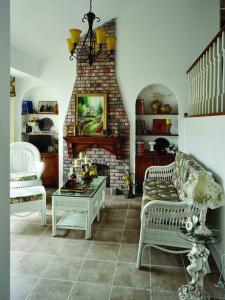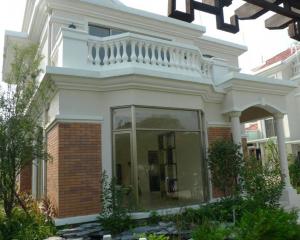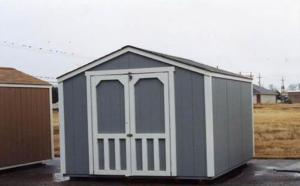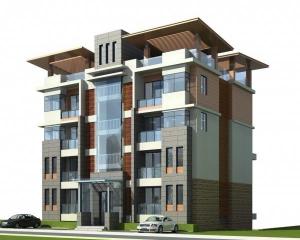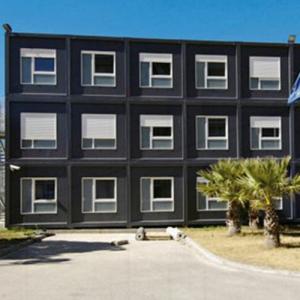low cost prefabricated wooden house
- Loading Port:
- China Main Port
- Payment Terms:
- TT OR LC
- Min Order Qty:
- -
- Supply Capability:
- -
OKorder Service Pledge
Quality Product, Order Online Tracking, Timely Delivery
OKorder Financial Service
Credit Rating, Credit Services, Credit Purchasing
You Might Also Like
low cost prefabricated wooden house
Wooden house, garden hose, children's play house
Product Advantage
| 1,Easy installation :two people can install a house in two days | ||||
| 2,Easy disassemble:two people can disasemble a house in one day. | ||||
| 3,Service life: 20 years or more | ||||
| 4,Competitive price:Compared to traditional construction cost saving more than 50% | ||||
| 5,Environmental protection and energy saving products: no construction waste, reusable, materials can be recycled. |
- Q: Are container houses suitable for educational or learning centers?
- Container houses can indeed be suitable for educational or learning centers. These unique structures offer several advantages that make them ideal for such purposes. Firstly, container houses are highly versatile and can be easily modified to cater to the specific needs of an educational center. They can be designed with multiple rooms or compartments, allowing for the creation of individual classrooms or activity areas. These spaces can be easily furnished and equipped with necessary educational materials, creating a conducive learning environment. Secondly, container houses are cost-effective compared to traditional brick-and-mortar buildings. Educational institutions often face budget constraints, and container houses provide a more affordable alternative. The initial cost of purchasing and converting containers is relatively low, and they require less maintenance and utility expenses over time. Furthermore, container houses are portable and can be relocated if needed. This flexibility allows educational centers to adapt to changing needs or move to more suitable locations. It also provides an opportunity for temporary learning centers in disaster-stricken areas or communities with limited resources. Container houses are also eco-friendly, as they repurpose used shipping containers that would otherwise end up in landfills. By using these containers for educational facilities, we contribute to sustainable practices and promote environmental awareness among students. Lastly, container houses can be designed with modern amenities such as air conditioning, heating, and proper insulation, ensuring a comfortable learning environment for students and teachers alike. In conclusion, container houses are highly suitable for educational or learning centers due to their versatility, affordability, portability, eco-friendliness, and the ability to provide modern amenities. They offer a unique and innovative solution for educational institutions looking to optimize their resources and create conducive learning spaces.
- Q: 100 square meters villa size how to calculate?
- in fact, easy to decorate the network Xiao Bian that the slope of the roof can be a good way to increase the effect
- Q: Are container houses suitable for people with disabilities?
- Depending on their specific needs and the modifications made to the container, container houses may be suitable for individuals with disabilities. The versatility and adaptability of container houses are one of their advantages. They can be personalized to meet the individual requirements of people with disabilities. For instance, ramps or lifts can be installed for wheelchair accessibility, doorways can be widened to accommodate mobility aids, and grab bars can be added to bathrooms for increased safety. Furthermore, container houses can be designed with open floor plans, providing ample space for easy movement and navigation for individuals with limited mobility. These open spaces also allow for customization and the installation of assistive devices like handrails or hoists to aid in daily activities. In addition, container houses can be designed to be energy-efficient and environmentally friendly, which can be beneficial for individuals with disabilities who have limited resources or specific environmental needs for their well-being. However, it is important to note that the suitability of container houses for people with disabilities depends on the specific disability and level of support required. Individuals with severe mobility impairments or those who need extensive medical equipment may find it challenging to adapt to the limited space and structural limitations of container houses. To conclude, container houses can be a viable option for people with disabilities if the necessary modifications and adaptations are made to accommodate their specific needs. It is crucial to consider the individual's unique requirements and consult experts or professionals in accessible design to ensure that container houses meet the required accessibility standards.
- Q: Can container houses be designed for adventure or outdoor tourism accommodations?
- Certainly, container houses are an excellent choice for adventure or outdoor tourism accommodations. In recent years, their popularity has soared due to their versatility, affordability, and eco-friendliness. These houses can be easily modified and tailored to suit different environments, making them a top choice for adventure seekers. One of the remarkable features of container houses is their ability to seamlessly blend with the natural landscape. This creates a unique and immersive experience for tourists, particularly when placed in remote locations like national parks, forests, or mountains. Visitors can bask in the beauty of nature while enjoying comfortable and well-equipped accommodations. Speaking of equipment, container houses can be equipped with various amenities to cater to the needs of adventure tourists. For instance, they can have designated storage spaces for outdoor gear, drying rooms for wet equipment, and built-in hooks or racks for hanging and drying gear. Additionally, these houses can incorporate sustainable features like solar panels for energy generation and rainwater harvesting systems, making them eco-friendly choices. Moreover, the flexibility of container houses shines through their ease of transportation and assembly. This allows for quick setup and dismantling, making them perfect for temporary or seasonal adventure tourism accommodations. They can serve as base camps for hiking or mountaineering expeditions, cycling or motorcycling tours, or even as glamping sites for those seeking a distinctive outdoor experience. In conclusion, container houses offer a practical and innovative solution for adventure or outdoor tourism accommodations. Their design can be tailored to suit the specific needs of the location and the tourists, ensuring a comfortable and sustainable stay while embracing the spirit of adventure and outdoor exploration.
- Q: Are container houses prone to leaks or water damage?
- When container houses are designed and constructed properly, they generally do not experience leaks or water damage. By ensuring adequate insulation and sealing, container houses can effectively keep water out. However, it is important to remember that the quality of materials and workmanship also play a significant role in preventing leaks and water damage, just like in any other type of construction. If a container is not sealed properly or has structural issues like rust or corrosion, it can potentially lead to leaks or water infiltration. To maintain the integrity of a container house and prevent water-related issues, regular maintenance and inspections are crucial. Additionally, directing water away from the foundation through proper drainage and landscaping around the house can reduce the risk of water damage. Overall, with careful planning, appropriate construction techniques, and regular maintenance, container houses can be just as resistant to leaks and water damage as traditional houses.
- Q: Can container houses be designed to have open floor plans?
- Yes, container houses can be designed to have open floor plans. The modular nature of container houses allows for flexible and customizable layouts, making it possible to create open and spacious living areas. By removing walls or using large windows and doors, the interior space can be designed to have an open concept, providing a sense of space and flow within the container house.
- Q: Can container houses be financed like traditional houses?
- Yes, container houses can be financed like traditional houses. Many banks and financial institutions offer loans and mortgage options specifically tailored for container houses. These loans function similarly to traditional home loans, with borrowers making regular monthly payments over a set period of time. However, it is worth noting that the financing options for container houses may vary depending on the lender and the specific circumstances. Some banks may have stricter lending criteria or different terms and conditions for container houses compared to traditional houses. It is advisable to consult with lenders who specialize in alternative housing options to explore the most suitable financing options for container houses.
- Q: Are container houses suitable for recreational or sports facilities?
- Container houses can definitely be suitable for recreational or sports facilities. These structures offer numerous advantages that make them an attractive option for such purposes. Firstly, container houses are highly versatile and can be easily customized and modified to meet specific requirements. This means that they can be transformed into various recreational or sports facilities, such as gyms, swimming pools, yoga studios, or even a clubhouse for a sports team. Secondly, container houses are cost-effective compared to traditional construction methods. The use of repurposed shipping containers significantly reduces the cost of materials, making it a more affordable option for creating recreational or sports facilities. This cost-efficiency allows for more resources to be allocated towards equipment, maintenance, and other essential aspects of the facility. Furthermore, container houses are also highly durable and resistant to harsh weather conditions. Their steel structure ensures stability and longevity, making them suitable for outdoor recreational or sports facilities. Additionally, container houses can be easily transported and relocated if necessary, allowing for flexibility in terms of the facility's location. Lastly, container houses are eco-friendly. Repurposing shipping containers helps in reducing waste and recycling materials. This aspect aligns well with the growing trend of sustainable and eco-conscious practices in the construction industry. While container houses may require some modifications and customization to cater specifically to recreational or sports needs, they offer a practical, cost-effective, durable, and eco-friendly solution for creating such facilities. Therefore, container houses are definitely suitable options for recreational or sports facilities.
- Q: Can container houses be designed with large windows for natural light?
- Yes, container houses can definitely be designed with large windows for ample natural light. The design and placement of windows can be customized to suit the specific needs and preferences of the homeowners.
- Q: Are container houses suitable for disaster relief shelters?
- Yes, container houses are suitable for disaster relief shelters. Container houses, also known as shipping container homes, are made from repurposed shipping containers, which are designed to be durable and withstand harsh conditions. This makes them highly suitable for disaster relief situations where durability and rapid deployment are crucial. Container houses offer several advantages for disaster relief shelters. Firstly, they are readily available and can be quickly transported to affected areas. Shipping containers are widely used for international trade, and therefore, they are easily accessible and can be repurposed for disaster relief purposes. This enables a rapid response to emergencies, providing shelter for displaced individuals and families in a timely manner. Secondly, container houses are designed to be sturdy and withstand extreme weather conditions. They are made of robust materials, such as corten steel, which are resistant to corrosion, fire, and strong winds. This ensures the safety and security of the occupants during disasters, protecting them from environmental hazards. Furthermore, container houses can be easily modified and customized to suit different needs and requirements. They can be stacked or combined to create larger living spaces or communal facilities, such as schools or medical centers. This versatility allows for flexibility in accommodating various needs, making container houses adaptable to different disaster relief scenarios. In addition, container houses are cost-effective compared to traditional construction methods. The use of repurposed shipping containers reduces the need for new materials and minimizes construction costs. This makes them a viable option for organizations and governments operating on limited budgets during disaster relief efforts. Overall, container houses are suitable for disaster relief shelters due to their durability, rapid deployment capabilities, adaptability, and cost-effectiveness. They provide a practical and efficient solution to address the immediate housing needs of disaster-affected communities, offering them a safe and secure environment during times of crisis.
Send your message to us
low cost prefabricated wooden house
- Loading Port:
- China Main Port
- Payment Terms:
- TT OR LC
- Min Order Qty:
- -
- Supply Capability:
- -
OKorder Service Pledge
Quality Product, Order Online Tracking, Timely Delivery
OKorder Financial Service
Credit Rating, Credit Services, Credit Purchasing
Similar products
Hot products
Hot Searches
Related keywords
